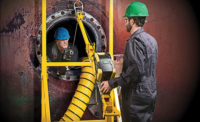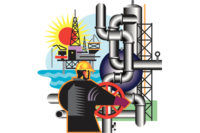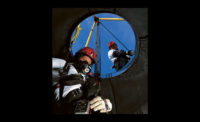OSHA's 29 CFR 1910.146, "Permit Required Confined Spaces for General Industry," defines a confined space as any area which has . . .
- adequate size and configuration for employee entry,
- limited means for access or egress,
- and is not designed for continuous employee entry.
The agency further defines a permit-required confined space as "a confined space that presents or has the potential for hazards related to atmospheric conditions (toxic, flammable, asphyxiating, engulfment . . . or any other hazard)." Permit-required confined spaces include boilers, storage vessels, furnaces, railroad tank cars, manholes and processing vessels.
Fall protection and retrieval
A fall protection and retrieval system for confined space activities consists of three major elements:
- a properly fitted full body harness,
- a fall arrest device (i.e. retractable lifeline),
- a suitable anchorage connector (i.e. tripod or davit).
If a fall occurs, the full body harness distributes the impact throughout the body and keeps the worker in an upright position. This makes retrieval easier.
For harsh working environments, the full body harness should be constructed of durable, comfortable synthetic fibers such as polyester, for acidic environments, or nylon, for caustic environments. Sub-pelvic support straps on the full body harness provide comfort to workers during prolonged suspension.
Connecting devices, the second major element of a confined space fall protection and retrieval system, are required to attach the entrant to an anchorage point. This equipment includes both two-way and three-way retractable lifelines which allow workers to enter a confined space under their own power.
Retractable lifelines allow the entrant freedom of movement while keeping the lifeline out of the worker's way. Should a fall occur, a centrifugal locking mechanism arrests the fall within inches. In an emergency, the topside attendant may use two-way and three-way retractable lifelines to raise an entrant to safety.
Three-way retractable lifelines can lower the entrant if he or she becomes wedged during a rescue.
A double-line system is especially effective for the emergency rescue of confined space workers in tanks, vaults and storage bins. With these systems, the entrant attaches to both a retractable lifeline and a personnel rated hoist.
When a hoist is used to lower or raise workers in and out of confined spaces, don't put the integrity of the rescue unit at risk. After the entrant is lowered, the hoist can be disconnected from the individual and used for lowering tools. Once the work is complete, the hoist should first be used to raise tools and equipment and then lowered to the worker for connection and retrieval.
One of the safest methods of lowering and retrieving workers in any confined space is with a double-line system consisting of a three-way retractable lifeline and personal/materials rated hoist.
Anchorage points, the third major element of a confined space safety system, are secured points for the attachment of lifelines and hoists. For the majority of confined space applications, a tripod or davit serves as a proper anchorage point. Most tripods and davits are designed to support a 5,000-pound static load, which is the strength requirement for anchorage as set forth by OSHA when used in personal fall arrest applications.
After a fall or rescue occurs, the personal fall arrest equipment should be removed from service and inspected by a company-appointed competent person. In most cases, it will be necessary to forward the equipment to the manufacturer for proper inspection and calibration to the manufacturer's specifications.
Employee participation
One of the most interesting dynamics of a well-planned safety program is the interaction of individuals involved.OSHA first requires the assignment of entrants, attendants, supervisors and trainers. Interaction between this team and training go hand-in-hand, with entrants, attendants and supervisors receiving both initial and refresher training relevant to their particular work situation. OSHA requires a record of all training sessions.
Training subjects typically include:
- hazards faced when entering a confined space, including symptoms and consequences of exposure;
- how to use appropriate equipment, including fall protection and retrieval gear; and
- maintaining communications between entrants and attendants.
Attendants should receive instruction in the behavioral aspects of potential exposure and learn about non-entry rescue and potential rescue hazards as well.
Most manufacturers of confined space equipment provide training aids and services in the form of videos, brochures, training clinics and on-site training.
Confined space supervisors should understand their responsibilities in declaring an area safe. Training in atmospheric testing ensures the maintenance of acceptable entry conditions as specified in the confined space permit.
Rescue teams, whether on- or off-site, must receive training. Any on-site responders should receive the same instruction as entrants, along with instruction in personal protective equipment and first aid. All potential respondents should practice confined space rescue annually.
However, only designated rescuers should attempt rescue operations. This is especially important since more than 60 percent of confined space fatalities are would-be rescuers.
Selecting Equipment
When it comes to protecting entrants, attendants and supervisors involved in confined space activities, don't underestimate the importance of selecting appropriate fall protection and retrieval equipment that best meets the specific needs of the job. Work in partnership with your manufacturer/distributor team to enhance the long-term value of your program.
According to Brian McDonald, president of McDonald Safety, headquartered in Wilmington, DE, and a Dalloz Fall Protection distributor, "OSHA is very serious about the standards. We recommend that companies should partner with a manufacturer/distributor team that offers the latest protective technology; lightweight, state-of-the-art equipment; application expertise and know-how, in addition to the continuing training and after-sale support that worker safety in confined space situations requires."
Regular Re-evaluation
A successful confined space fall protection program is a continual process. All aspects of the program should be regularly re-evaluated. A professional should inspect all equipment before and after each use. Your equipment manufacturer should provide information on inspection, cleaning, storage and maintenance. And finally, refresher training should be made available for all entrants, supervisors and rescuers.
A thorough understanding of OSHA requirements, the company's confined space policies and procedures, proper use of personal protective equipment and rescue procedures should be communicated and clearly understood by all employees and supervisors within the confined space environment. The agency estimates that compliance with its standards can prevent approximately 54 fatalities and 5,000 injuries annually. A knowledgeable workforce makes for a productive and safe working environment.
A lesson learned
The city of Vancouver's Fire Department experienced the perils of confined-space rescue when it responded to a call in the summer of 1993.A ship worker had descended through a manhole into the seven-foot high chamber to inspect the ballast area of a barge, while a second worker remained above. When the second worker lost verbal contact with the man in the ballast, he summoned a first aid attendant to the site and called the fire department.
What the firefighters discovered in the tomb-like ballast was appalling - all three men lay unconscious and near death. Obviously, waiting for them to arrive, the first aid attendant and the second worker had entered the ballast in an attempt to rescue the worker.
The three victims were lifted out of the ballast to the barge deck and given immediate resuscitation. Tragically, the first aid attendant could not be revived and died at the scene.
Later, fire department personnel tested the air in the ballast and found it contained only 15 percent oxygen, well below the normal 20.9 percent. Extensive rusting of the ballast walls and floor had consumed much of the available oxygen, making the chamber a veritable death trap. (Source: OH&S Canada, Aug./Sept. 1997)
Statistics show that almost 60 percent of confined space fatalities are not the initial victim, but the would-be rescuers. Often times, injuries and fatalities are the result of falls that occur after a person loses consciousness when exposed to toxic fumes.
Had the first ship worker used a full body harness, retractable lifeline with emergency recovery and/or a personnel-rated hoist, it would not have been necessary for rescuers to enter the confined space at all.
Having learned from the experience, the Vancouver Fire Department stepped up its training and equipment acquisition programs. The department now has 62 specially trained rescue technicians who have completed 140 hours of initial instruction, and who drill twice per month both in-house and in actual field conditions. Ten trainers and rescue instructors now serve the department's 800 fire fighters and officers.
The department has also acquired new equipment such as SAR (supplied air respirators) for confined space rescue, and small escape bottles (which supply 10 to 15 minutes of back-up air) along with new air monitoring and ventilation equipment. Tripods and mechanical advantage rope systems are used for lowering and retrieving personnel from confined spaces. A second line, equipped with a full-body harness and shock-absorber, is used for fall protection.
According to Fire Chief Tom Easterbrook, the results of these efforts have been three successful rescues in the past 18 months, each requiring the additional fall protection equipment and training.


